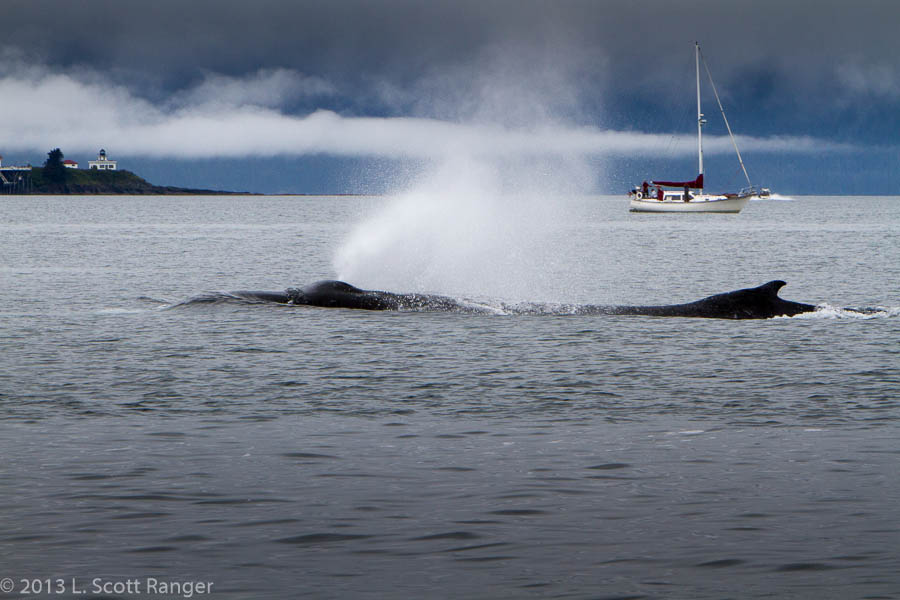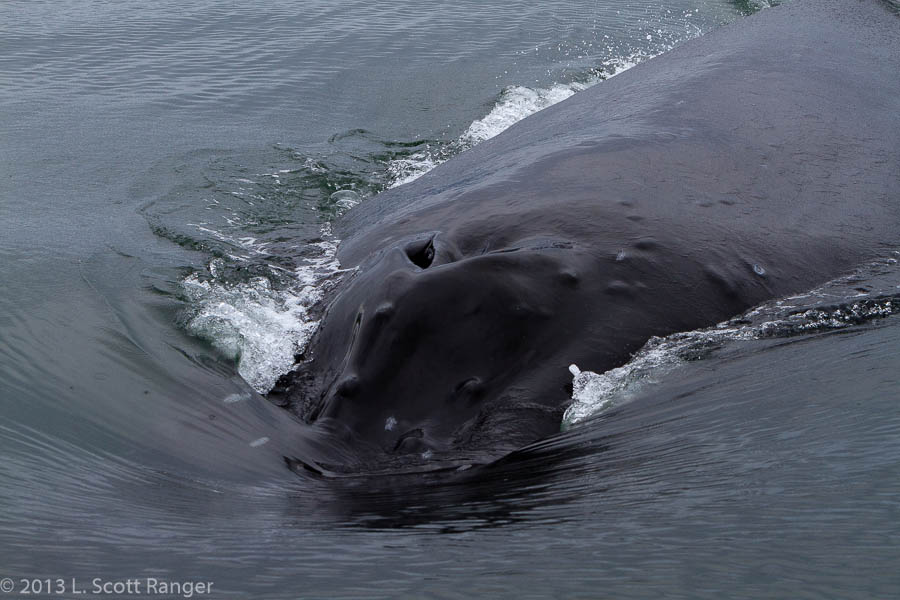Cruising and Spouting
By far the most common behavior I see is cruising and spouting. I can truthfully state that I see this every time I’m on the water. When we leave Auke Bay and are searching for whales, spouting is what the captain and naturalist are looking for above the surface of the water. Spouts are nearly always the first thing we see and on all but “split pea soup” fog days are easily seen at distances of about five miles or less. That being said, it takes vigilance and extensive use of one’s peripheral vision. It helps to be “out of the gate” after whale watching boats have already left. On a tour in 2009 Captain Gary Judkins and I went an hour and 45 minutes before spotting a whale!
Cruising and spouting is the one behavior I can be virtually certain about what I see: the whale is simply swimming from here to there and breathes with each surfacing. The normal pattern is a rise of the blowhole to just above the surface with a blow followed by submerging. The dorsal fin emerges with the backbone exhibiting a gentle arc, then it submerges. The sequence repeats itself over and over again as long as the whale is travelling. The time between blows is often less than 30 seconds, but can be much longer. There is no mystery here.
The shape and size of the blow can be a great help at identifying the whale species being observed. The spout of a humpback whale is quite distinctive from other whales. It is a nearly vertical column shaped like an ice cream cone, narrow at the base and broad at the top. It can easily reach 3 to 12 meters above the water surface. Surface winds can affect the orientation of the blow and the vertical blow is with calm conditions. I must admit to absolute joy when the spout of a whale wafts through the open windows of the boat. The smell is definitely unpleasant, but at the same time exciting. It makes me wonder what sort of microorganisms live within the lungs of these leviathan and if breathing them in might lead to some pathology!
Cruising and spouting is the one behavior I can be virtually certain about what I see: the whale is simply swimming from here to there and breathes with each surfacing. The normal pattern is a rise of the blowhole to just above the surface with a blow followed by submerging. The dorsal fin emerges with the backbone exhibiting a gentle arc, then it submerges. The sequence repeats itself over and over again as long as the whale is travelling. The time between blows is often less than 30 seconds, but can be much longer. There is no mystery here.
The shape and size of the blow can be a great help at identifying the whale species being observed. The spout of a humpback whale is quite distinctive from other whales. It is a nearly vertical column shaped like an ice cream cone, narrow at the base and broad at the top. It can easily reach 3 to 12 meters above the water surface. Surface winds can affect the orientation of the blow and the vertical blow is with calm conditions. I must admit to absolute joy when the spout of a whale wafts through the open windows of the boat. The smell is definitely unpleasant, but at the same time exciting. It makes me wonder what sort of microorganisms live within the lungs of these leviathan and if breathing them in might lead to some pathology!
Humpbacks have two nostrils located on the highest part of the skull as a splendid adaptation to their aquatic environment. They are separated by a septum made of both bone and hyaline (nearly transparent) cartilage. When open, a bowl forms above each that can hold more than a quarter liter of water. Much of the spout is made of this water that is vaporized upon exhaling. As the whale dives, a single external valve closes both nostrils simultaneously so no water enters. These two photos were taken less than a second apart showing the closing of the valve!
Since the blowhole is above the surface for mere seconds, it requires that some 90% of their lungs be exhaled and then inhaled in a very few seconds. It is estimated that the speed of a humpback’s breath is more than 300 kmh, easily enough to vaporize the moisture in their lungs as well as the water in their nostrils.
Since the blowhole is above the surface for mere seconds, it requires that some 90% of their lungs be exhaled and then inhaled in a very few seconds. It is estimated that the speed of a humpback’s breath is more than 300 kmh, easily enough to vaporize the moisture in their lungs as well as the water in their nostrils.



